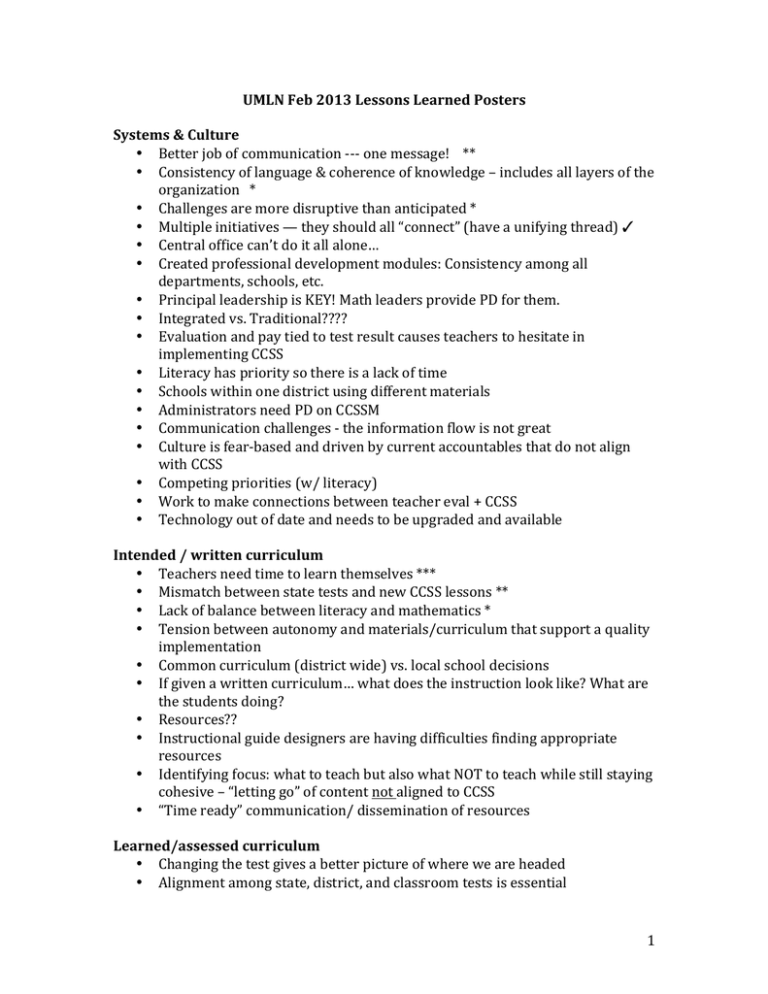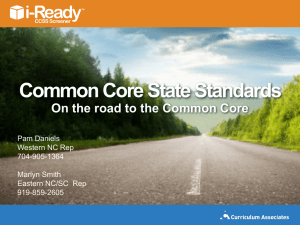Document 11664012
advertisement

UMLN Feb 2013 Lessons Learned Posters Systems & Culture • Better job of communication -­‐-­‐-­‐ one message! ** • Consistency of language & coherence of knowledge – includes all layers of the organization * • Challenges are more disruptive than anticipated * • Multiple initiatives — they should all “connect” (have a unifying thread) ✓ • Central office can’t do it all alone… • Created professional development modules: Consistency among all departments, schools, etc. • Principal leadership is KEY! Math leaders provide PD for them. • Integrated vs. Traditional???? • Evaluation and pay tied to test result causes teachers to hesitate in implementing CCSS • Literacy has priority so there is a lack of time • Schools within one district using different materials • Administrators need PD on CCSSM • Communication challenges -­‐ the information flow is not great • Culture is fear-­‐based and driven by current accountables that do not align with CCSS • Competing priorities (w/ literacy) • Work to make connections between teacher eval + CCSS • Technology out of date and needs to be upgraded and available Intended / written curriculum • Teachers need time to learn themselves *** • Mismatch between state tests and new CCSS lessons ** • Lack of balance between literacy and mathematics * • Tension between autonomy and materials/curriculum that support a quality implementation • Common curriculum (district wide) vs. local school decisions • If given a written curriculum… what does the instruction look like? What are the students doing? • Resources?? • Instructional guide designers are having difficulties finding appropriate resources • Identifying focus: what to teach but also what NOT to teach while still staying cohesive – “letting go” of content not aligned to CCSS • “Time ready” communication/ dissemination of resources Learned/assessed curriculum • Changing the test gives a better picture of where we are headed • Alignment among state, district, and classroom tests is essential 1 K-­‐2 assessments aligned to CCSS and PARRC prototype open-­‐ended multiple correct answers • District assessment at a different level than teacher–made assessment (benchmark tests) • Not there yet • Incorporating performance-­‐based assessments • Begin item (question) assessment bank for teachers. *Not mandatory • Pilot benchmark assessments (field items that mirror CCSS) • State DOE selected 2 focus clusters grades 3-­‐8. Constructed response assessments provided October, February, May; removed 25% state standards but remains. • Need for vetted vendors of PARCC type items • Need for item specs from PARCC • New curriculum is not aligned to the current state assessment and teachers are yet to pay attention to the CCSS–type assessment (Math Practice) Taught/ enacted curriculum • Understanding the depth of standards * • Drilling down to the “students” level to determine if learning is taking place. * • Instructional tasks SMPs • Offered PD on certain domains • Help teachers move to “units” instead of day to day pacing o Understand depth • Designing PD around units to be taught based on timelines. This is done cyclically. • Integration of CCSS • CCSS Look-­‐fors app • Need accountability • PD for principals, so they look for best practices for math instruction • Implemented unit of study using Agile Mind (7th) • Elective credit available in summer using Agile Mind • Teachers use current instructional resources; district does PD to transition to CCSS by highlighting resources • District writes curriculum (scope/sequence) with infused CC links and resources. MUST have more PD to implement with rigor! • Using Intensified Algebra for level 1 students • What is taught is what is assessed; enacted curriculum is based on the assessment • Extent to which students and teachers would need scaffolding and support was greater than anticipated—underestimated readiness levels. • Knowing content and practices deeply enough to use identified resources; balance of effort/PD resources between math and ELA • 2






